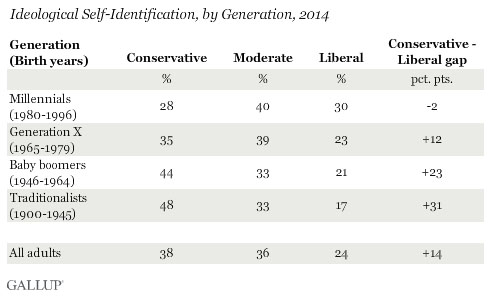U.S. Baby Boomers More Likely to Identify as Conservative
Jeffrey M. Jones, Gallup, January 29, 2015
Older generations of Americans are much more likely to describe their political views as conservative than as liberal. This includes the large baby boom generation, of whom 44% identified as conservative and 21% as liberal last year. That 23-percentage-point conservative advantage is less than the 31-point edge for the older traditionalist generation, but greater than those for Generation Xers and millennials. In fact, millennials are about as likely to say they are liberal as to say they are conservative.
The results are based on aggregated data from 14 separate Gallup polls conducted in 2014, including interviews with more than 16,000 U.S. adults, aged 18 and older.
{snip}
Throughout the past two decades, the relative conservatism of each generation has been consistent, even as the members of each generation have aged. Those born before 1946 have been the most conservative generation in every year going back to 1994, based on the percentage of the generation identifying as conservative minus the percentage identifying as liberal. Baby boomers have been less conservative than traditionalists, but more conservative than Gen Xers and millennials each year since 1994, spanning the period when baby boomers moved from being in their 30s or 40s to now when they are in their 50s or 60s.
The consistency in the relative rank of the generations over time reflects the fairly constant ideological preferences of each generation. Net conservatism among traditionalists typically has been about 30 points, while the conservative edge among baby boomers has been about 20 points, and millennials have been close to even.
The ideological preferences of Gen Xers have varied a bit more over time, with the conservative advantage closer to 10 points in the 1990s and mostly in the mid-to-high teens since then. Since 2012, the conservative lead among this generation has shrunk, as there has been a slight drop in conservative identification (from 39% to 35%) and a slight increase in liberal identification (from 21% to 23%). This change has occurred about equally among the younger and older people in Generation X.
{snip}
















